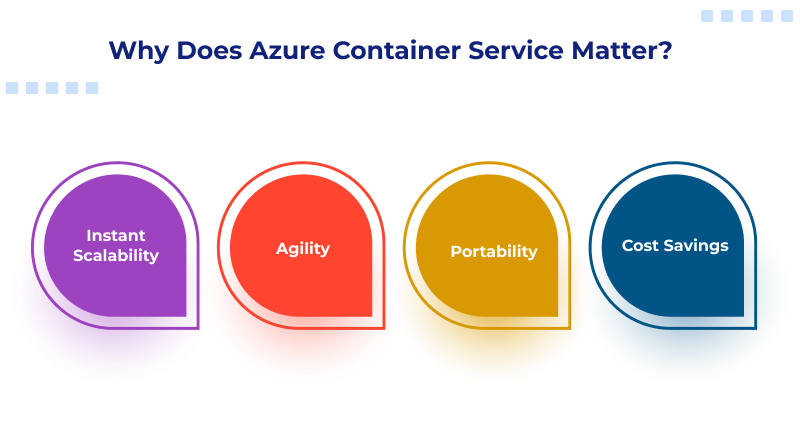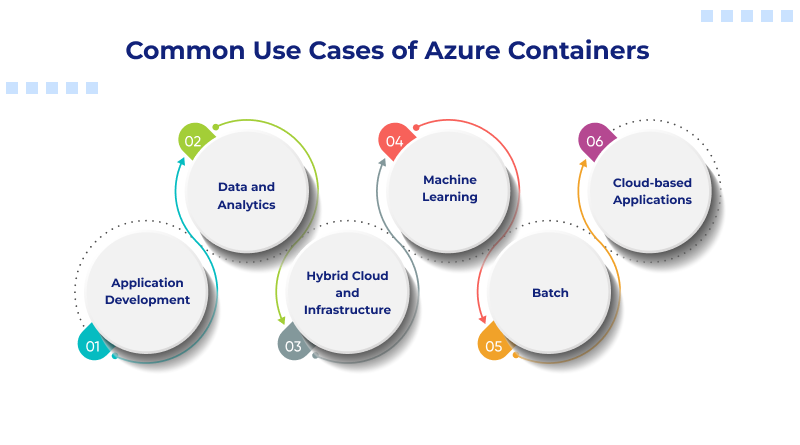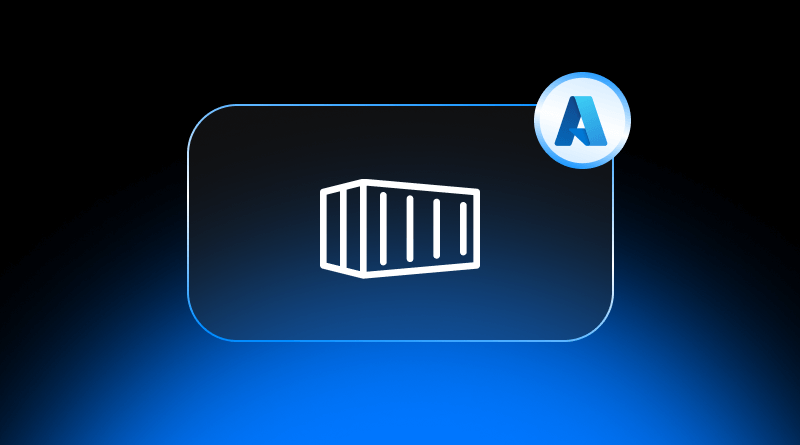Have you ever packed your belongings into a suitcase for a journey? All you require—clothing, gadgets, chargers—fits into one convenient, travel-sized bag. That’s what a container does for your app.
Consider this: just as your favourite WordPress website operates seamlessly on trustworthy WordPress hosting, containers keep your application running reliably—regardless of where it’s deployed. All it requires—code, libraries, settings—is packed into one standalone package.
Now, when it comes to handling these containers at scale, Azure provides powerful solutions that make it simple to deploy, manage, and scale your applications, whether you’re hosting a custom application or spinning up WordPress in a containerized deployment. In this blog, we’ll explore what are containers in Azure, inspect their key features, and walk through how Azure container services simplify deployment at scale.
Let’s start with what containers are all about—and how Azure makes them possible.
Table Of Content
What is a Container?
A container is a standard, lightweight packaging for your applications. It combines an application’s code with the corresponding configuration files and repositories as well as the dependencies necessary for the application to execute. This allows developers to deploy applications easily across diverse platforms.
Most of the time applications do not work properly when transferred from one environment to another. This is because of configuration differences, underlying library or other dependency requirements. Containers tackle this challenge by wrapping applications in a compact, self-sufficient environment—streamlining deployment without the complexity of traditional setups.
A container packs your app, its settings, and everything it needs to run into one image. You test it once, and it works anywhere—like sending a ready-to-go package straight to the host system. Containers thus allow developers and IT experts to deploy applications across environments with minimal or no change—this defines the Azure containers definition at work.
What is Azure Container Service?
Azure Container Service is a scalable cloud platform that enables developers to host their applications in a lightweight, portable way. It streamlines container management by smartly handling operations, networking, scaling, and other complicated tasks. Microsoft’s cloud computing platform supports robust containerized applications, making it easy for developers to leverage the power of Azure containerization.
Azure Container Service instances also enable integration with other services like Azure Kubernetes and Azure Service Fabric so that users can choose their preferred container orchestration platform.
Using Azure Container Service is beneficial in many ways. Users can run their apps whenever they need by deploying them in the cloud. Additionally, users who are interested in testing, developing, and installing their applications in a swift manner will find it appealing due to its fast and simple installation procedure. In addition to that, the Azure container service pricing is very affordable.
Why Does Azure Container Service Matter?
What makes Azure container service truly valuable is how it simplifies the whole process—you don’t have to wrestle with setup or management. It is a useful resource for users utilizing containerization and cloud computing technology. Below are a few reasons why Azure container benefits are so significant:

– Instant Scalability
Owing to their minimal footprint, Azure containers can run side by side in the same environment, maximizing resource usage without compromising performance. The lightweight nature of containers allows them to begin and close quickly, enabling instant upgrades and downgrades.
– Agility
Developers can now bundle their applications into containers and leave it to IT to deploy on a uniform platform. It diminishes the amount of effort required to deploy apps as well as simplifies the entire development and testing process. As a result, it makes it easier for the teams to collaborate and become more efficient in shipping applications quickly.
– Portability
Containers use a standardized form of packaging and storing all the components required to execute any application efficiently. It addresses the issue of applications being executed on some machines and provides portability across OS platforms and clouds. So, whenever a container is deployed, a container runs in a consistent environment, making it a major benefit of containers Azure offers.
– Cost Savings
You only pay for what you consume with Azure Container Service, which makes it a perfect option for small businesses or start-ups who wish to save their expenses, owing to its cloud technology.
Common Use Cases of Azure Containers
To manage and deploy containerized applications in the cloud, you can use Azure container service for distinct scenarios. Below are some common use cases.

1. Application Development
Azure Container Service is the perfect resource for the deployment and management of containerized applications throughout the development cycle. It allows developers to deploy, test, and set up their applications quickly and safely without needing to possess a thorough understanding of the basic environment. This acts as a strong introduction to Azure containers for development teams.
2. Data and Analytics
With the use of Azure Container Service, data scientists are able to install and handle big data and analytics applications in a safe and segregated environment like Hadoop and Spark-based clusters.
3. Hybrid Cloud and Infrastructure
Organizations can create secure, hybrid-cloud infrastructure by taking advantage of the containers in the Azure ecosystem. By blending public and private cloud environments, Azure offers a flexible, hybrid model that scales effortlessly and adapts to evolving business demands.
4. Machine Learning
Containers allow machine learning applications and software to be self-contained as well as easily scalable across various environments. This depicts why you should use containers Azure in data science workflows.
5. Batch
Batch processing would generally imply operations that are possible without the intervention of human beings or which could be done on a resource-available basis. Resizing images, creating reports, and file format conversions are some examples. Containers offer a seamless medium to execute batch jobs without the need to sustain an environment or dependencies.
6. Cloud-based Applications
Containers give cloud-based applications a shared operating pattern across environments, be they public, private or hybrid. Containers’ low overhead and high density make them the perfect choice for delivering cloud-based applications—showcasing real-world Azure container benefits.
Container-Optimised Tools And Services
Explore these container-optimised tools and services that enable you to attain agility, security and portability.
– DevOps
When containers are paired with DevOps methodologies, teams are able to deploy code quicker and reduce application development cycles.
– Security
As your containers need to be treated with a layered methodology, they should be secured using CI/CD pipelines.
– Serverless Containers
Container agility can be seamlessly enhanced on demand. Serverless container technologies execute containers without taking care of servers.
– Orchestration
While operating containers at scale, orchestration, and management of containerised apps through an orchestration container like Kubernetes is required.
Steps to Create a Container in Azure
To create a container in Azure, you can proceed as follows:
- Log in to the Azure portal.
- Choose the “Create a resource” option.
- Search for “Container” and choose “Container Instance”.
- Tap on the “Create” button.
- Insert the essential information like subscriptions, and resources from the “Basics” menu.
- Select the container image you would like to utilize.
- Specify the size of the container, CPU, and memory requirements.
- Customize networking and ports.
- Select the “Review + Create” button to confirm the configuration.
- After verification, tap on the “Create” option to set up the container.
After that, your container instance will be up and running, and you will be able to access it using the provided networking customization and ports.
In a nutshell, Azure Container Service is the most suitable option for everyone, willing to make containerized application deployment, management, and scaling easier. Thanks to the flexible and scalable infrastructure of Azure Container Service, developers are able to execute containers easily across different platforms and infrastructures. This liberates you from concerns about the underlying infrastructure so you can focus on building your applications and delivering your client’s exceptional user experience.
Companies can accelerate their digital transformation efforts, enhance their potential, and respond faster to changing client demands by leveraging the Azure Container Service. So, what are you waiting for? Register for Azure Container Service immediately and discover the difference it can make for your business.
FAQ
Why are containers a key technology for cloud-native applications on Azure?
Containers offers a lightweight, portable medium to develop and deploy applications with ease. Azure facilitates accelerated development, simplified testing, and seamless scaling—perfect for cloud-native environments. That’s why most teams adopt container technology Azure to update their workflows.
What are the main Azure services designed for deploying and managing containers?
Azure provides resources such as Azure Kubernetes Service, Azure Container Instances, and App Service for Containers. These benefits of containers Azure make deployment easy, providing developers with remarkable choices to deal with containers.. To get a rapid introduction to Azure containers, these are the basics to learn.
How do Azure containers contribute to application scalability and resilience?
With automatic recovery, load balancing, and scaling, Azure containers keep your applications reliable across various loads. All these benefits of azure technology ensures that your apps can adapt and recover with the least downtime.
Can I migrate existing applications to containers in Azure?
Indeed. Azure accommodates containerizing old applications, and you can wrap them with all the dependencies and shift them to the cloud. This is a wise move towards Azure containerization without requiring you to re-write your whole codebase.















